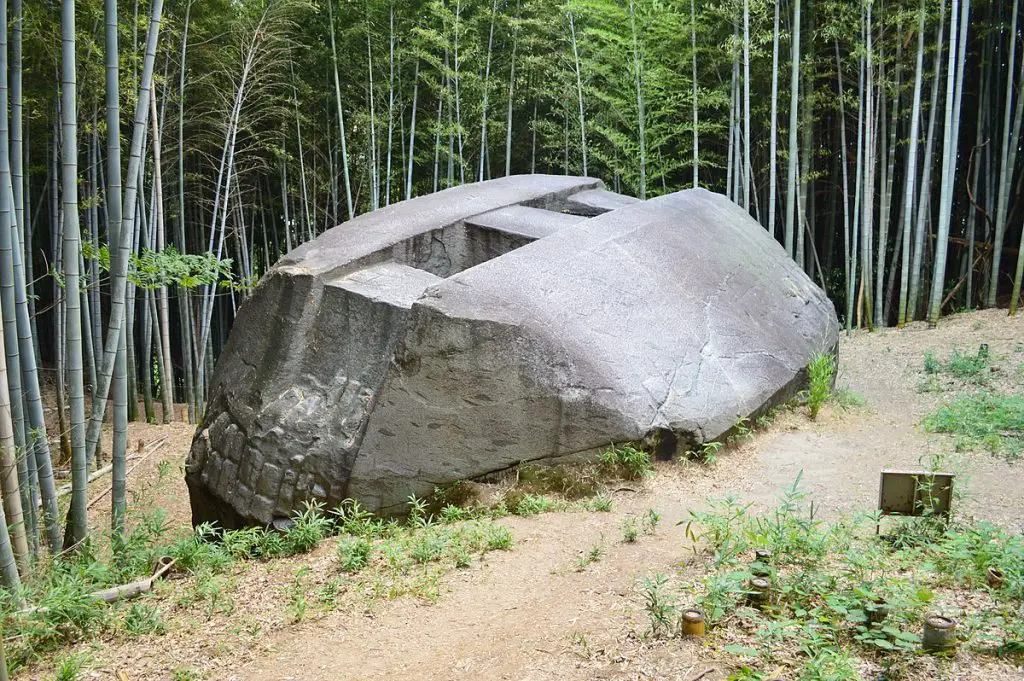Nestled in the verdant landscapes of Japan’s Nara prefecture lies a mystifying relic of the past, known as the Rock Ship of Masuda (aka Masuda-no-iwafune). This enigmatic structure, carved with precision and shrouded in mystery, has captured the imagination of historians, archaeologists, and enthusiasts of ancient mysteries alike. The Rock Ship, with its massive size (weighing in at more than 800 tons) and peculiar features, stands as a silent testimony to a time long gone, beckoning us to delve deeper into the mysteries of Japan’s rich and often inscrutable past.
In this investigation, we embark on a journey to explore the Rock Ship of Masuda, attempting to unravel the secrets it holds. From its discovery to the myriad of theories that surround its origin and purpose, we’ll dive into the depths of historical analysis, local folklore, and cultural significance. Join us as we navigate through the enigmatic waters of one of Japan’s most intriguing ancient mysteries.

Historical Context and Discovery
Tucked away in the Asuka region of Nara, Japan, the Rock Ship of Masuda has long stood as a silent witness to the passage of time. Discovered in the modern era, this colossal structure immediately drew attention due to its sheer size and the mystery surrounding its creation. The Asuka region, rich in historical significance, was once the cradle of Japanese civilization, where early states formed and Buddhism took root in Japan.
Historians believe that the Rock Ship was carved during the Asuka period, a time marked by significant cultural and political change in Japan. This era, spanning from 538 to 710 AD, saw the introduction of major cultural influences from mainland Asia. The region is dotted with ancient tombs and ceremonial sites, but the Rock Ship stands out due to its unique form and unclear purpose.
Early interpretations by local scholars suggested that it could be a ceremonial platform or part of a larger, now-lost structure. However, the lack of definitive historical records left much to speculation. The initial discovery did not just stir academic curiosity; it also ignited the imaginations of locals and visitors, leading to numerous legends and myths about its origin.
Description of the Rock Ship of Masuda
The Rock Ship of Masuda, measuring approximately 11 meters in length, 8 meters in width, and 4.5 meters in height, is a testament to ancient craftsmanship. Carved from a single massive rock, its most striking features are the two square holes at its top and the precise, straight lines that define its shape. These characteristics are not commonly found in other ancient Japanese structures, lending to the mystery of its purpose and origin.
In comparison to other ancient stone structures around the world, the Rock Ship has a unique architectural style. Unlike the megalithic structures of Stonehenge in England or the precise stonework of the Incas in South America, the Rock Ship’s simplistic yet precise design sets it apart. This difference in architectural style has puzzled historians and archaeologists, leading to various interpretations of its significance and function.
Theories and Speculation
The Rock Ship of Masuda, with its enigmatic presence, has given rise to a spectrum of theories and speculations. One of the most prevalent theories suggests that it was used as an astronomical observation site. The precise alignment of the holes with specific celestial bodies during certain times of the year supports this theory, indicating a sophisticated understanding of astronomy by its creators.
Another popular theory proposes a religious or ceremonial purpose. The Asuka period was a time of significant religious activity in Japan, with the introduction and spread of Buddhism. Some scholars speculate that the Rock Ship could have been a part of ritual practices or a symbolic representation in a now-lost religious narrative.
There are also more unconventional theories, ranging from it being a part of ancient energy grids, to claims of extraterrestrial influence, reminiscent of theories surrounding other ancient structures like the pyramids of Egypt. While these ideas are often considered fringe by mainstream archaeologists, they continue to intrigue and attract a global audience, eager for explanations beyond the conventional.
Amidst these theories, what remains clear is that the Rock Ship of Masuda is an extraordinary artifact from Japan’s ancient past, one that challenges our understanding of the capabilities and intentions of its creators.
Cultural Significance and Local Legends
The Rock Ship of Masuda is not just an archaeological enigma; it is also a significant cultural landmark steeped in local legends. In Japanese folklore, such structures are often seen as connections to the spiritual world. Local stories and myths speak of the Rock Ship as a vessel for spirits or a bridge between the earthly and the divine realms.
This cultural significance is reflected in the reverence shown by locals to the site. It is often visited during traditional festivals and is a subject of folklore tales told to children in the region. These stories, while varied, commonly depict the Rock Ship as a mystical creation, made by gods or supernatural beings, highlighting the deep-rooted connection between the Japanese people and their ancient heritage.
The influence of the Rock Ship extends beyond folklore. It has become a symbol of the mysterious past of Japan, inspiring artists, writers, and even filmmakers, who have used it as a backdrop for stories blending history with fantasy.
In essence, the Rock Ship of Masuda is a cultural touchstone, embodying the rich tapestry of Japanese history, mythology, and artistic expression.
Connections with Other Ancient Structures
The Rock Ship of Masuda, while unique in its design and location, shares some intriguing parallels with other ancient structures across the globe. A comparative analysis reveals a fascinating web of similarities and differences, offering insights into the diverse approaches to construction and symbolism by ancient cultures.
One notable parallel can be drawn with the megalithic sites in Europe, such as Stonehenge in the UK. Both structures exhibit a clear alignment with celestial bodies, suggesting an advanced understanding of astronomy. However, unlike the monolithic and circular arrangement of Stonehenge, the Rock Ship’s rectangular shape and distinct carved holes offer a different perspective on the ancient builders’ intentions and cultural context.
In South America, structures like the precise stonework of the Incas display a similar mastery over stone carving. The Incas, known for their intricate stone walls that fit together without mortar, showcase a craftsmanship paralleling the precise cuts seen in the Rock Ship. Yet, the Incas’ work often served clear architectural and ceremonial purposes, while the Rock Ship’s function remains more elusive.
These comparisons underline the diversity in ancient construction techniques and purposes. They also highlight a common thread among ancient civilizations – a drive to create monumental structures that align with astronomical phenomena and hold significant cultural or spiritual meaning.
Despite these similarities, each ancient structure, including the Rock Ship of Masuda, stands as a unique testament to the ingenuity and cultural identity of its creators. They challenge us to expand our understanding of ancient civilizations, reminding us that there is much to learn from these enduring monuments of human history.
Current Understanding and Continuing Mysteries
Despite extensive research and numerous theories, the true purpose and origin of the Rock Ship of Masuda remain shrouded in mystery. Modern archaeology has yet to provide conclusive evidence that unravels the full story behind this enigmatic structure. The Rock Ship, with its stark design and precise construction, continues to defy easy categorization or explanation by scholars.
The current understanding leans towards it being a product of the Asuka period’s cultural and architectural experimentation, possibly serving multiple purposes, including astronomical observation. However, this interpretation is far from being universally accepted, and many questions remain unanswered. Why were the two square holes carved into the rock? Was it purely for functional purposes, or did they hold a symbolic meaning? How did the creators achieve such precision with the limited technology available at the time?
These unanswered questions add to the allure of the Rock Ship of Masuda, making it a subject of ongoing fascination and study. The mystery is compounded by the lack of written records from the period, leaving archaeologists and historians to piece together the puzzle from the physical evidence alone.
The Rock Ship of Masuda, therefore, stands as a captivating enigma, a reminder of the complexities and depths of Japan’s ancient history, waiting for further discoveries and interpretations.
Closing Comments
The Rock Ship of Masuda is more than just an ancient structure; it is a symbol of the enduring mystery and rich cultural heritage of Japan. Its very existence challenges our understanding of the past, inviting both scholars and the public to ponder the capabilities and intentions of ancient civilizations. As we continue to explore and interpret this fascinating relic, it stands as a testament to the human spirit’s quest for meaning and mastery over its environment.
While the full story behind the Rock Ship may still lie hidden beneath the veils of history, its allure remains undiminished. It continues to inspire curiosity and awe, drawing visitors from around the world and keeping the flame of ancient mysteries alive. What secrets does it hold? The answer awaits, hidden in the stone and the stars, a puzzle for future generations to unravel.






